CEX Risk Assessment Guide: Three Key Indicators to Anticipate Crises
Original Author: CryptoVizArt, Glassnode
Original Compilation: Nan Zhi, OdailyNews
Key Points Summary
- Exchanges remain the core of the digital asset industry, with the vast majority of trades occurring here;
- According to entity-adjusted data, our assessment shows that 54% of BTC activity is related to deposits or withdrawals from exchanges;
- Drawing lessons from the FTX collapse, we introduced three indicators to assess abnormal exchange activity: internal transfer rate, exchange dependency rate, and whale withdrawal rate;
- Using this exchange risk framework, we evaluate Binance, Coinbase, Huobi, and FTX to provide an overview of various exchanges' on-chain behaviors.
Exchange Balances
CEX holdings peaked at 3.203 million bitcoins in March 2020 and have steadily declined since then. This week (end of August), total exchange balances reached a five-year low of 2.256 million bitcoins. These exchange balances consider wallets directly related to exchanges, excluding dedicated custodians or ETF tools (such as GBTC or Microstrategy).
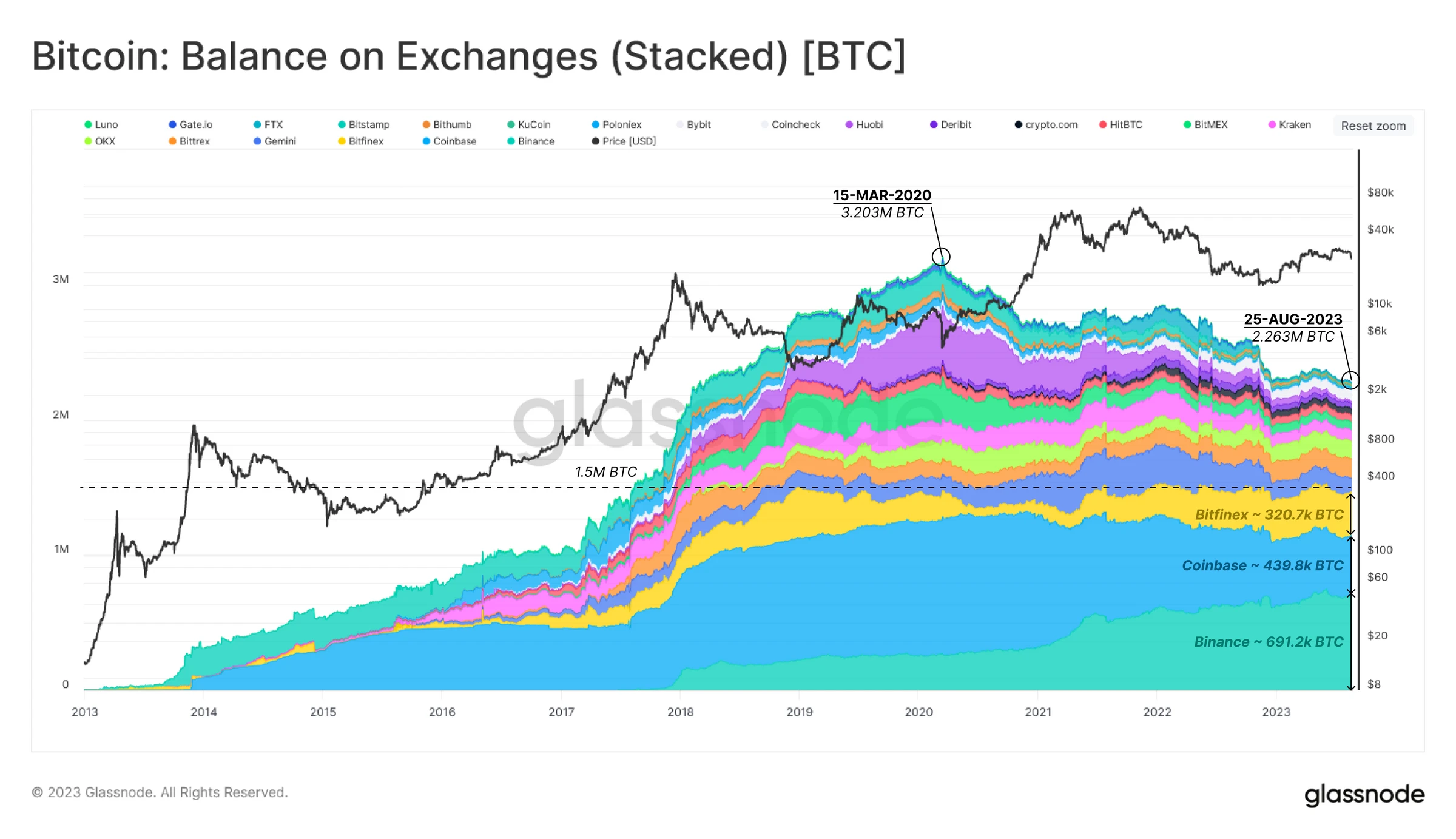
A notable feature of this chart is that the top three exchanges dominate, holding around 1.5 million bitcoins since early 2019. The current estimated holdings of these exchanges are as follows:
- Binance: 691,200 bitcoins
- Coinbase: 439,800 bitcoins
- Bitfinex: 320,700 bitcoins
After excluding 1.457 million bitcoins considered lost, the exchange reserves account for 11.8% of the circulating supply, totaling 2.31 million bitcoins, while the daily on-chain transfer volume is 122,000 bitcoins (0.6%).
Of this 122,000 bitcoins in trading volume, deposits or withdrawals from exchanges account for over 54% (approximately 67,300 bitcoins daily, typically with deposits and withdrawals each making up half). Therefore, observing the inflow and outflow of funds to and from exchanges often contains quite rich information.
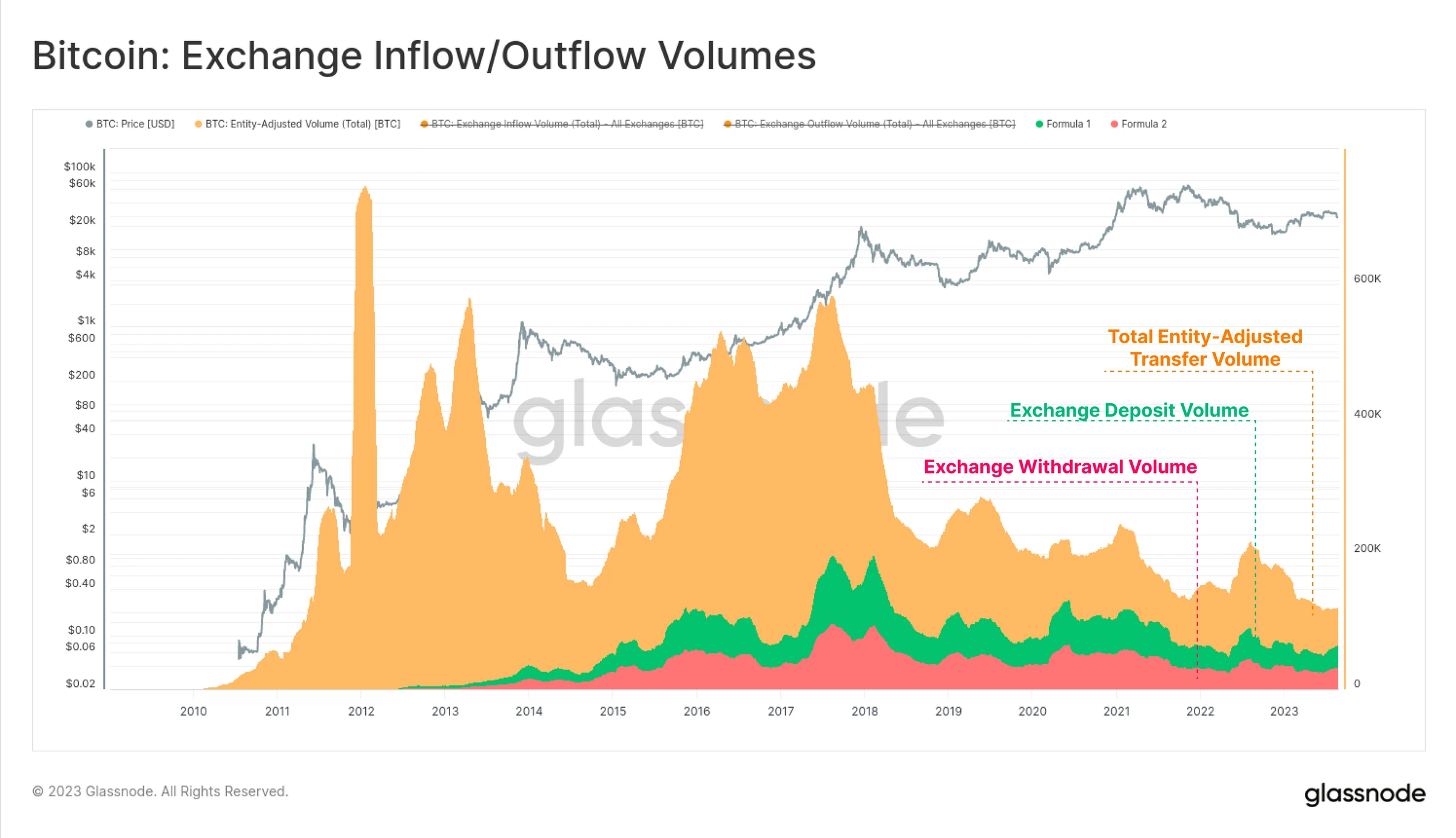
Fund Flow Analysis
After understanding the scale of the flows, we can delve deeper into the funds flowing between entities and exchanges. In the chart below, we sum the inflows and outflows of exchanges to form a single metric, which is the exchange fund flow (taking a 90-day average).
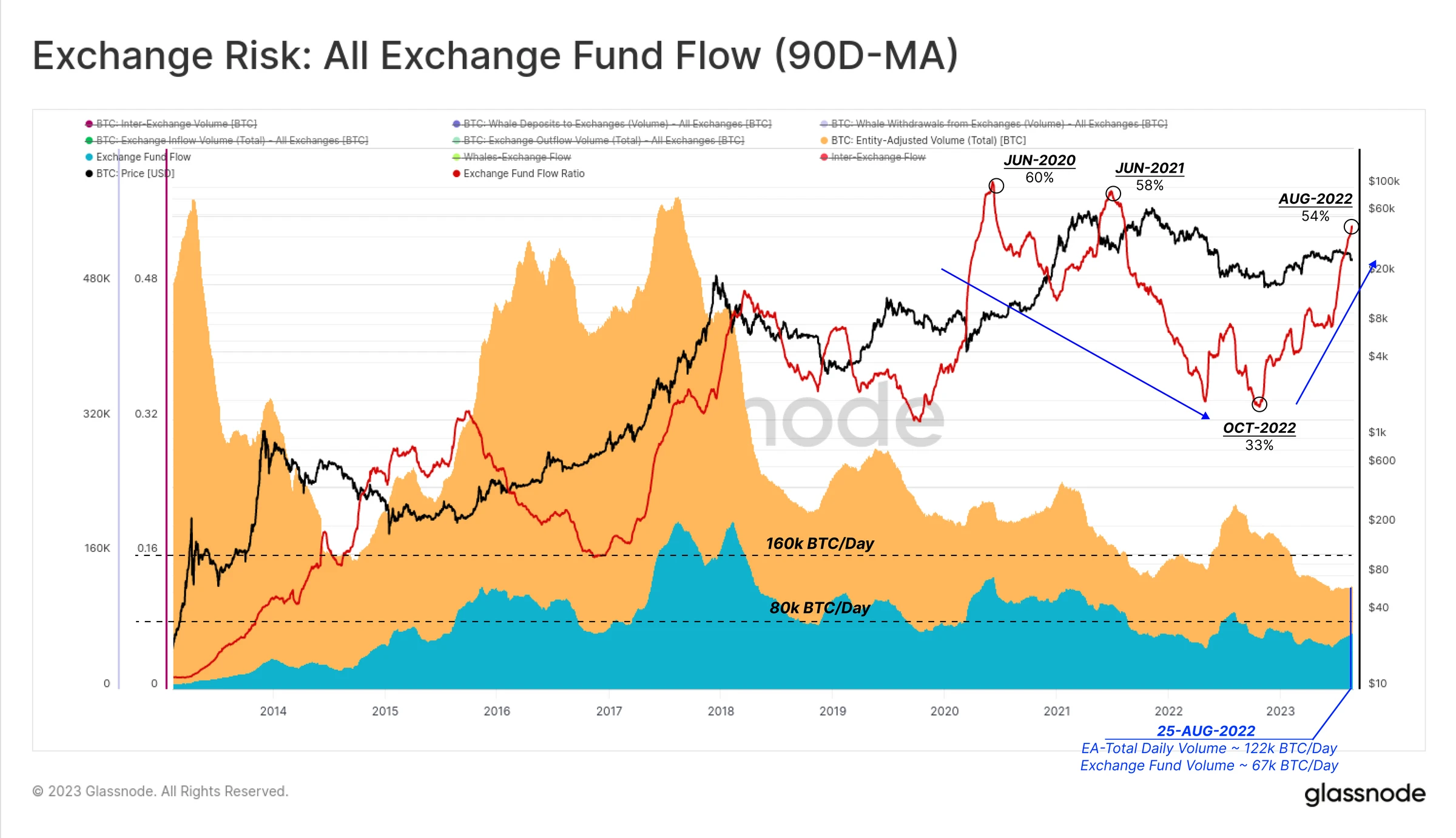
Here, we can see that exchange fund flows have reached 54% of the total and are in a macro upward trend. The exchange share peaked at 58% in June 2021 and then sharply declined with the rapid rise in global interest rates, liquidity tightening, and the subsequent bear market. In October 2022, as global liquidity and markets recovered from the impact of the FTX incident, dominance rose again.
We can break down the dominance of on-chain trading flows into four parts:
- On-chain trading volume unrelated to exchanges (entity-adjusted).
- All flows related to exchanges (inflows and outflows).
- Fund flows between whales and exchanges: transfers of funds between whales (1,000 BTC +) and exchanges.
- Flows between exchanges: transfers of funds from one exchange to another.
Flows between exchanges have remained relatively stable, accounting for about 7.5% of on-chain trading volume, peaking at 11.7% in June 2021. Meanwhile, the flow between whales and exchanges recently reached a new historical high of 17.9%.
As we can see, exchange-related flows (54%) are currently close to historical highs.
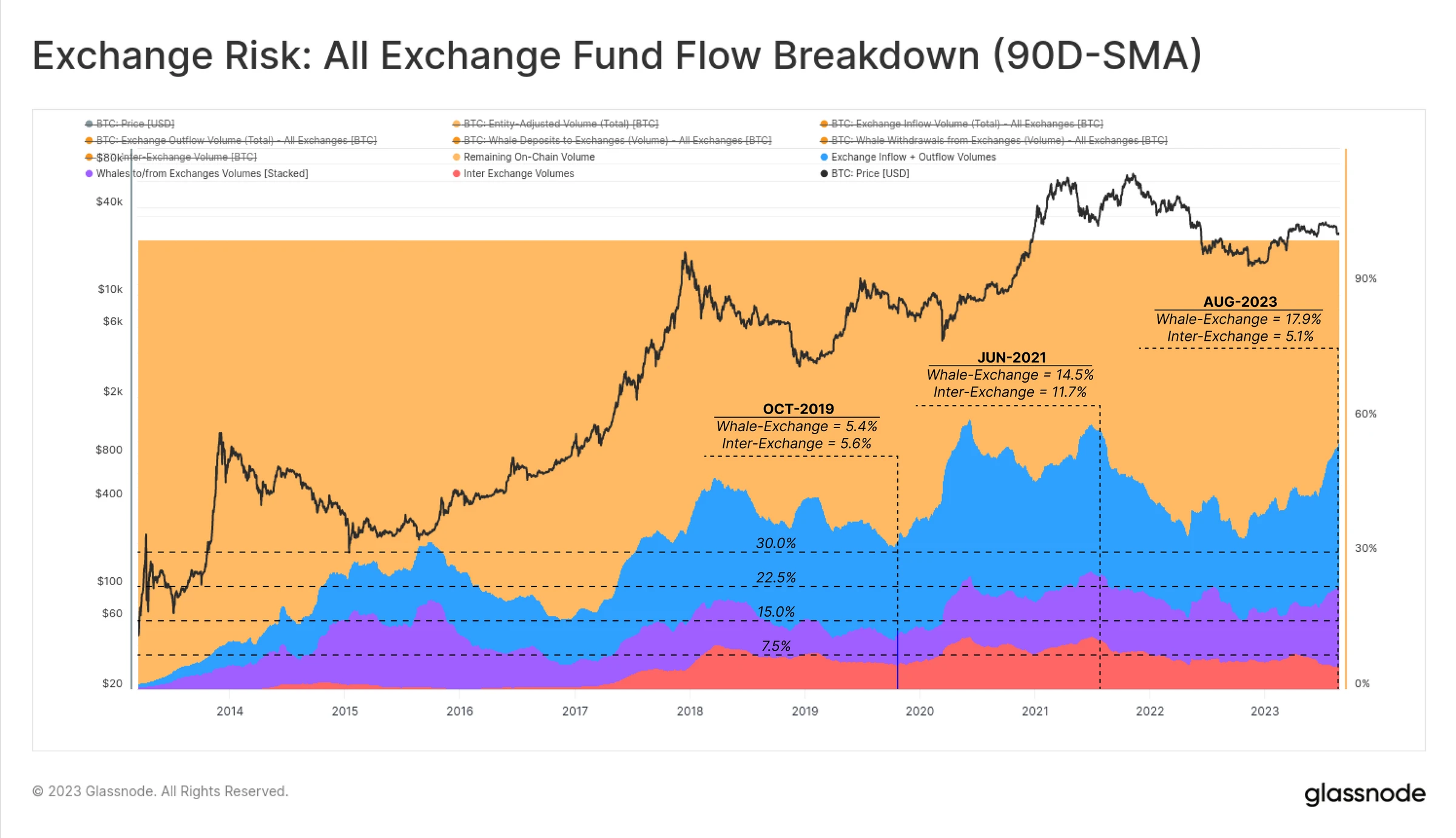
Exchange Risk Analysis Framework
The first part of the report establishes the perspective of exchanges' dominance in the Bitcoin ecosystem. However, after the FTX incident, exchanges may also become sources of counterparty risk.
In the following sections, we aim to establish a framework for analyzing the relevant risks of individual exchanges. In this section, we will use the FTX dataset as a reference point for future high-risk situations. Considering Coinbase's dominance and recent market commentary regarding Binance and Huobi, we will provide data related to these exchanges for comparison.
We will use three indicators to construct this framework:
- Internal transfer rate - the ratio of internal transfers over a period to total reserves.
- Exchange dependency rate - the degree of flow between exchanges (transfers between exchanges).
- Whale withdrawal rate - a measure of large entities accelerating fund withdrawals.
Internal Transfer Rate
The first indicator is the amount of internal wallet transfers within exchanges relative to the total reserve balance of the exchange. To provide comparable metrics across all exchanges and assets, the output value ranges from 0 to 1.

The core idea is to identify situations where internal transfers within the exchange exceed 100% over a 7-day period. If this situation persists over a long time and across multiple asset types, it may signal mismanagement of funds.
For FTX, we can see that their internal transfer rate for Bitcoin maintained at 1.0 from March 2021 until the collapse in November 2022. We also present a "comprehensive risk" score that considers the four largest assets: BTC, ETH, USDC, and USDT.
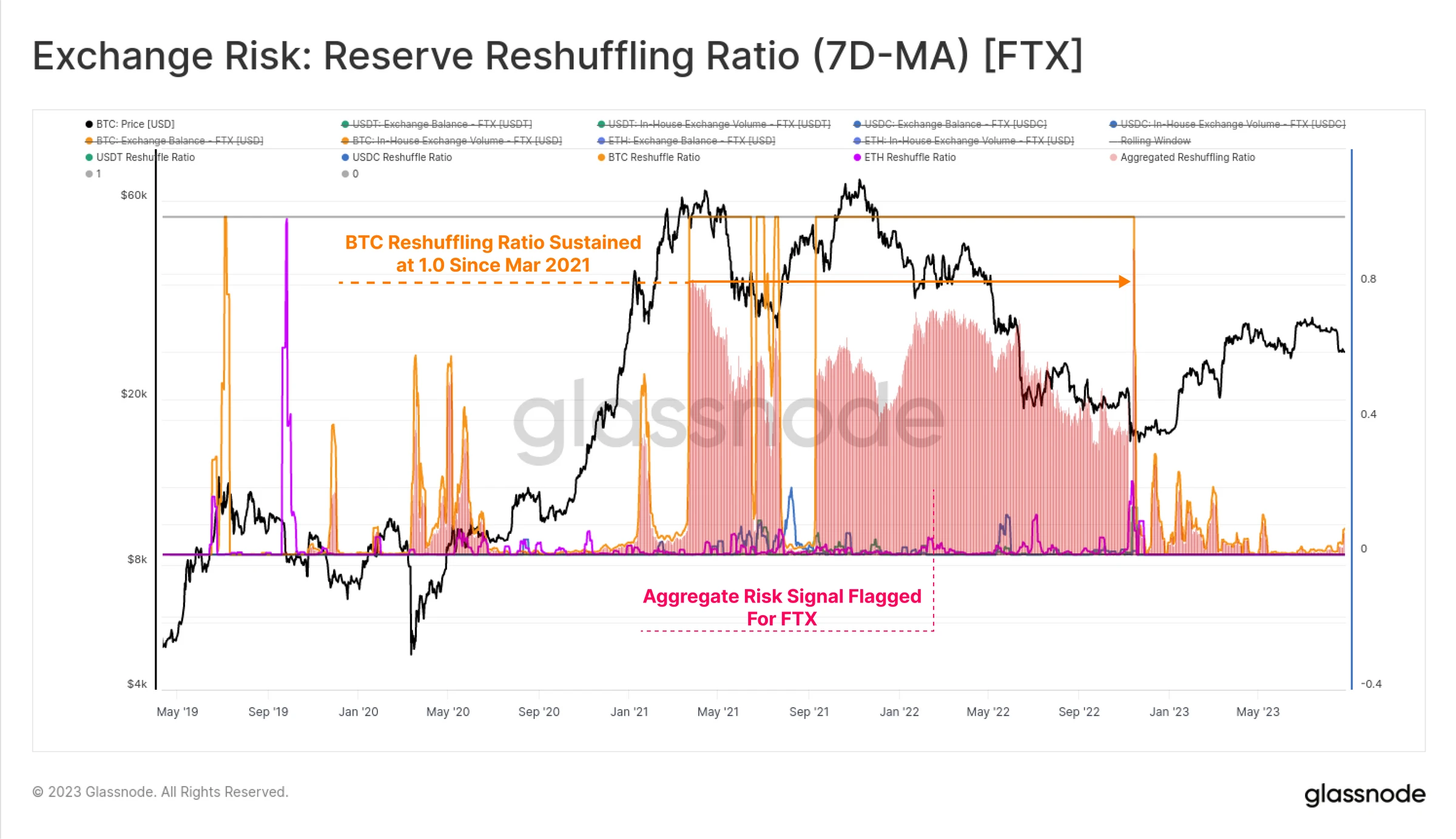
When compared to the other three exchanges, we can see some specific nuances:
- Binance (top left): During periods of market volatility, the internal transfer rate spiked across all assets and then quickly declined. This appears to be a market reaction and is not persistent, likely resulting from new deposits and withdrawals being processed.
- Coinbase (top right): Aside from USDC maintaining at 1.0 for an extended period, there are few internal transfer events. This is likely related to Coinbase's partnership with issuer Circle and its role as a primary venue for USDC inflows and outflows.
- FTX (bottom left): The internal transfer rate for Bitcoin entered a high-risk zone in the 14 months leading up to the exchange's collapse. In hindsight, this was likely the result of Alameda misappropriating customer funds.
- Huobi (bottom right): This exchange exhibited volatility-related activity similar to Binance.
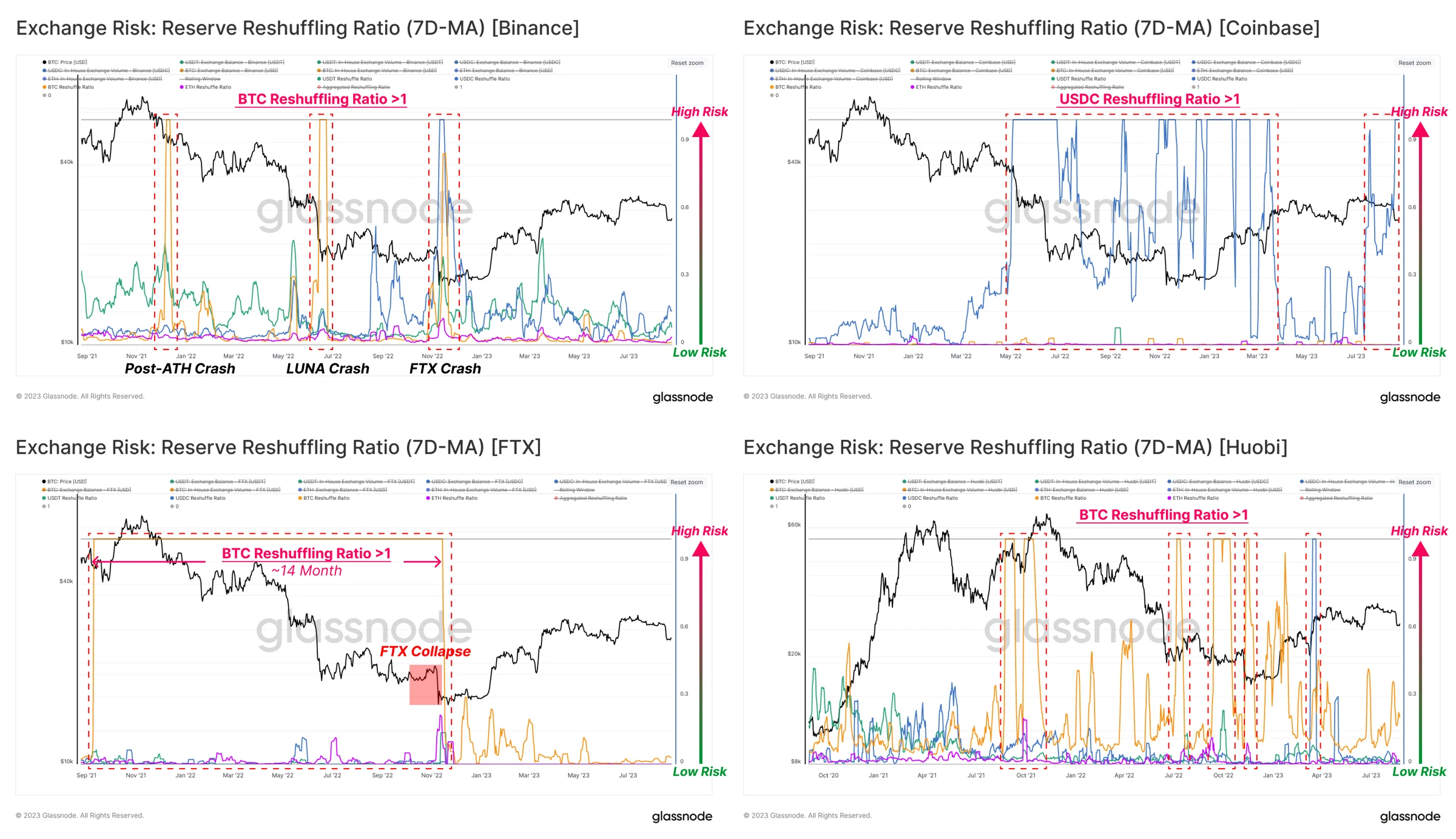
The chart below compares the internal transfer rates of these four exchanges across four assets. Here, we used a 5% threshold to mark potential high-risk events. From this perspective, Binance and Coinbase show almost no internal "volatility."
As we now know, FTX stands out for various reasons, but all are negative.
Huobi is positioned in the middle, with an internal transfer rate similar to Binance, but due to the exchange's asset balance gradually declining (the denominator decreasing), volatility is greater.
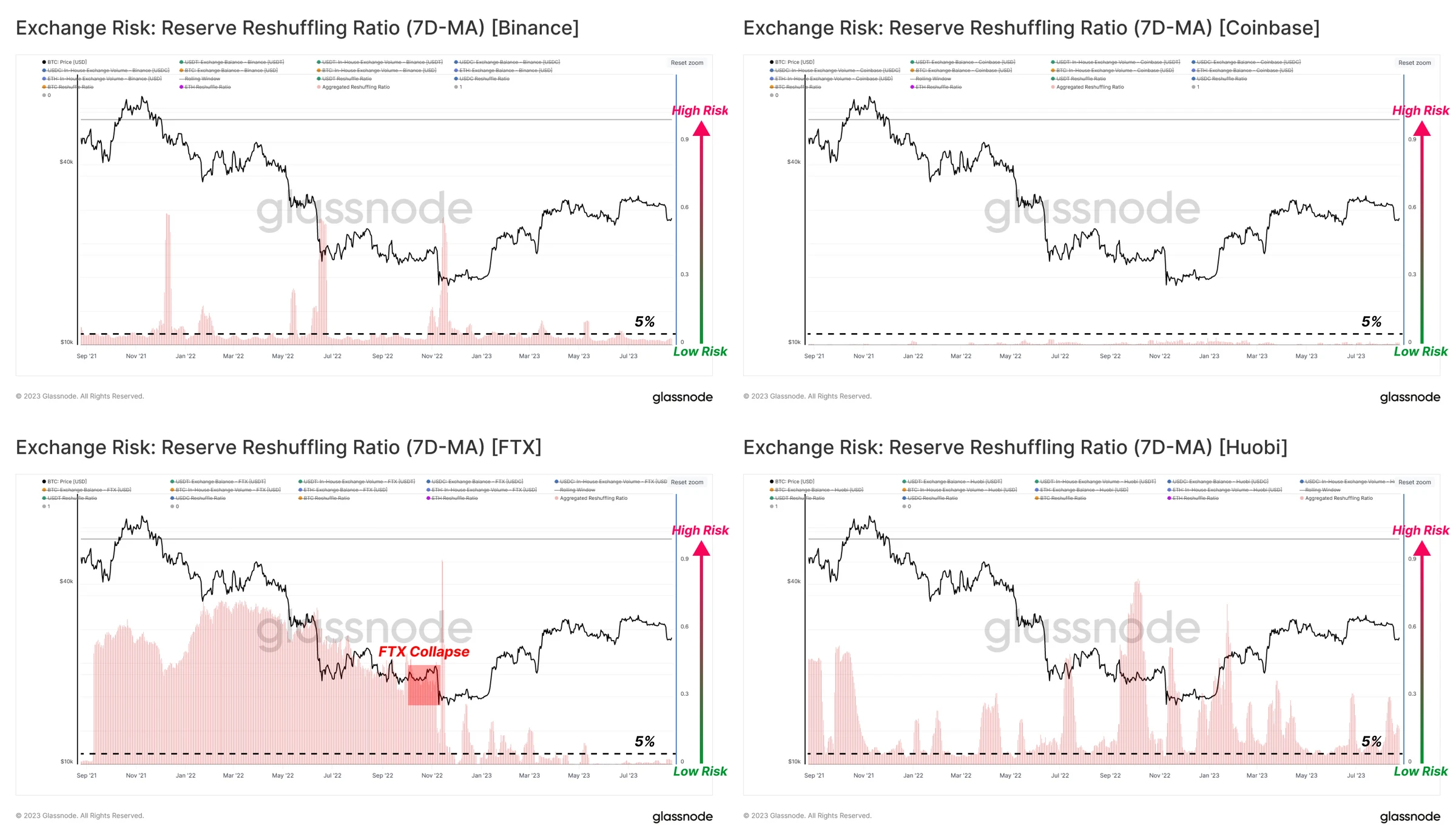
Exchange Dependency Rate
Another indicator of potential exchange risk is the frequency with which exchange tokens are transferred in or out from another exchange. This may indicate a high degree of liquidity dependency between these exchanges.

Similar to the previous section, we calculated this ratio for the top four assets in the market and limited the output values to a range of -1 to 1. We can also observe the direction of funds by whether the ratio is positive (net inflow) or negative (net outflow), as well as investigate the sources and destinations of the funds.
A significant negative value in this indicator suggests that assets are rapidly flowing out of the exchange and into another exchange, which, if sustained over time, may trigger alarms.
Reviewing the top four assets of the aforementioned exchanges:
- Binance (top left): All assets show neutral or near-zero dependency rates, indicating that the funds flowing in or out from other exchanges are small compared to Binance's balance. Since September 2022, the inflow rate of USDC has been high, likely sourced from Coinbase.
- Coinbase (top right): Similar to Binance, all assets show neutral dependency rates. However, since September 2022, the outflow rate of USDC has been high. This indicates that a significant amount of USDC supply has migrated from Coinbase to Binance over the past 12 months.
- FTX (bottom left): The dependency rates for all four assets were significantly negative before the exchange's collapse. This indicates that investors (and Alameda) were transferring all major assets to other exchange accounts.
- Huobi (bottom right): Evaluating Huobi's risk indicator, we can see that all assets have large negative dependency rates, indicating a net outflow to other exchanges.
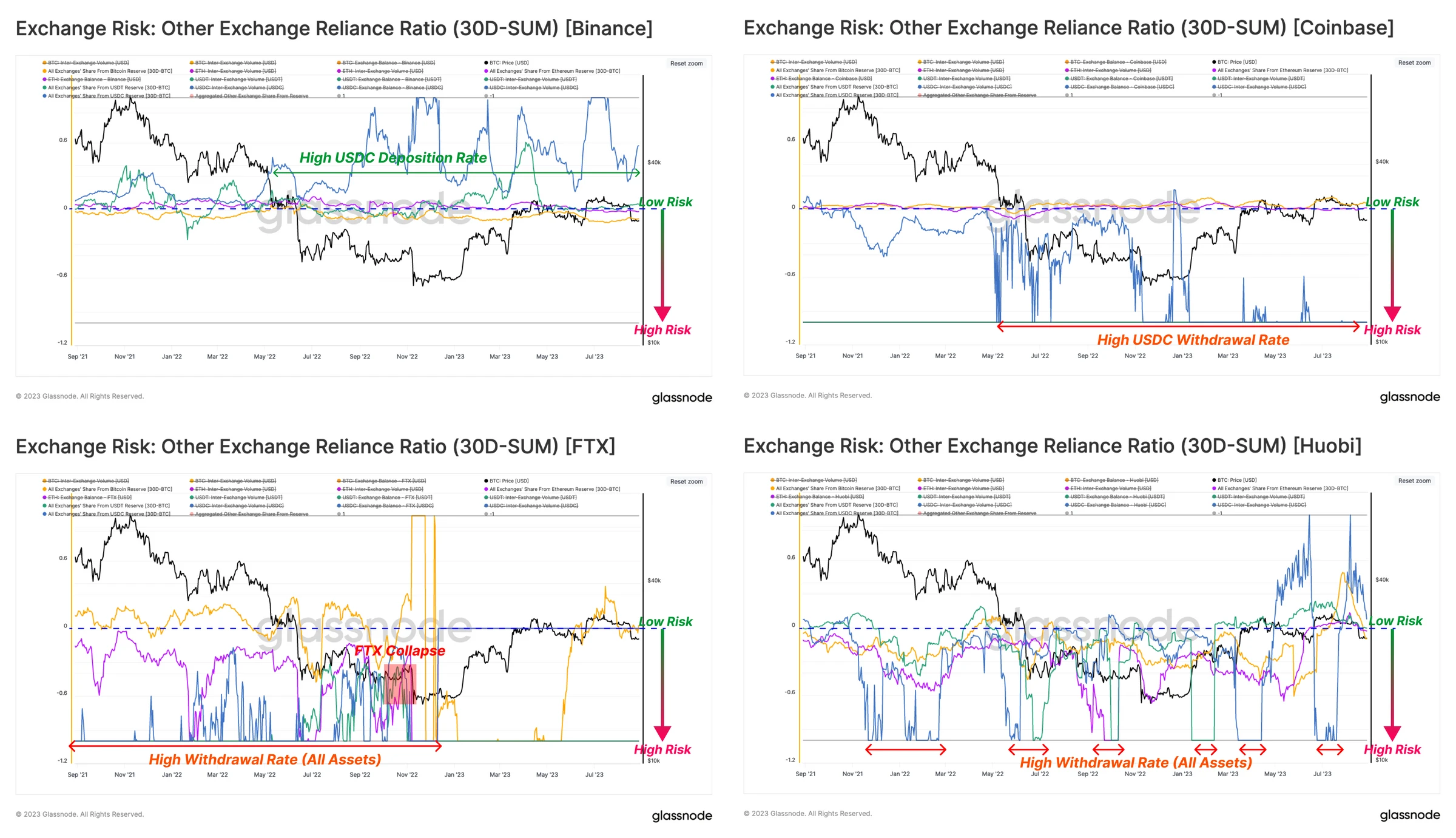
We again present the comprehensive dependency rate, which shows that Binance and Coinbase have very low dependency rates, at -5% or higher, indicating that their behaviors are largely independent of other exchanges.
On the other hand, FTX and Huobi have negative comprehensive dependency rates, indicating that entities active in other exchanges have been continuously withdrawing funds from these entities.
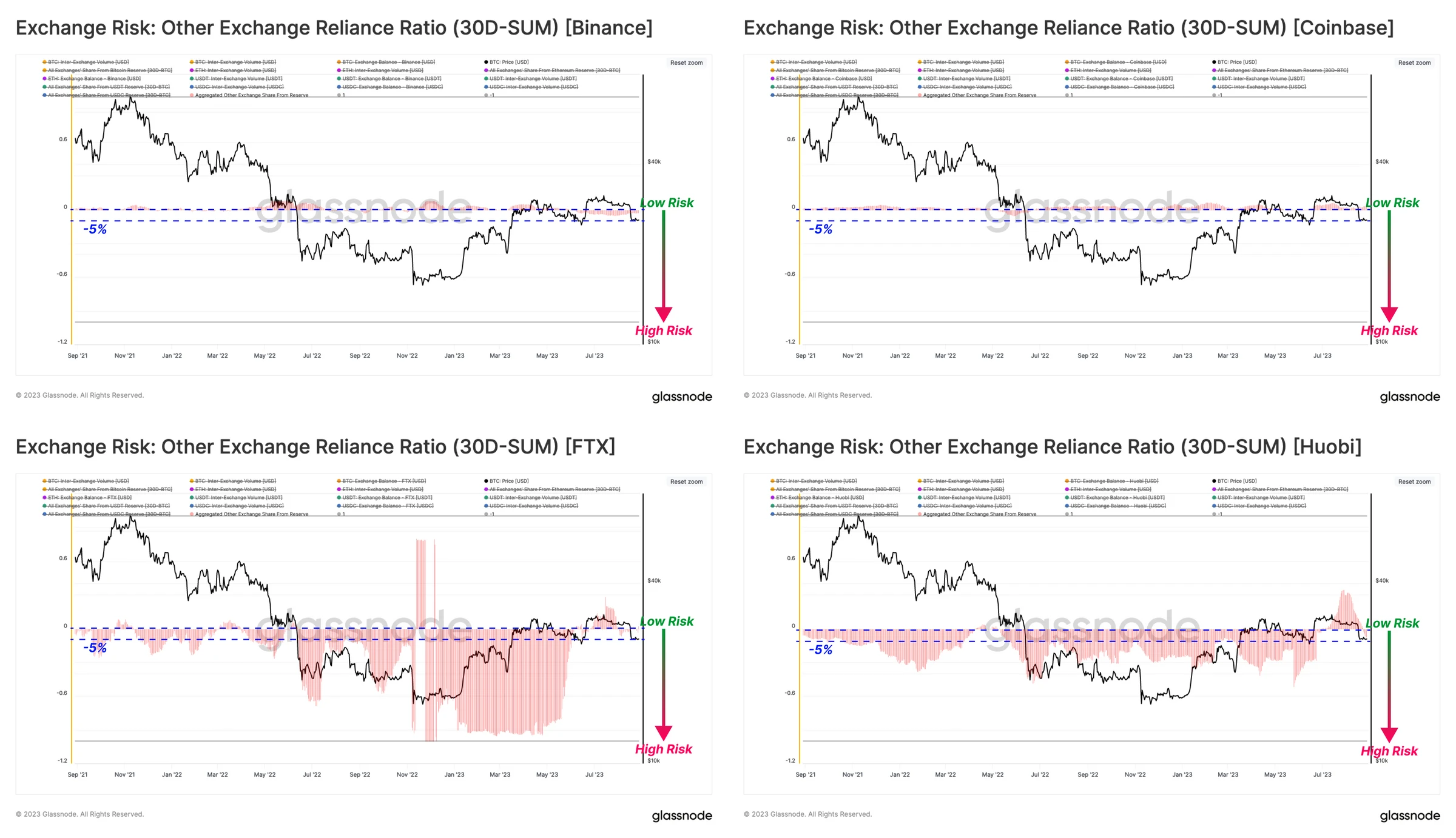
Bitcoin Whale Withdrawal Rate
The final indicator monitors whether Bitcoin whales are accelerating their withdrawals. This parameter is the ratio of total weekly whale outflows to the exchange's Bitcoin balance.

In addition to the whale withdrawal rate, we also present the historical average of this indicator as a long-term benchmark.
- Over the past two years, the whale withdrawal rates for Coinbase and Binance have been very low, with long-term averages remaining below 5%;
- For FTX, the surge in whale withdrawal rates began with the collapses of LUNA and 3AC and remained high until the exchange's closure;
- For Huobi, the risk was relatively low until June 2023. It is only in recent months that the whale withdrawal rate has continued to rise relative to Huobi's BTC balance. This will, to some extent, drive Huobi's BTC balance to continue declining, as this indicator has reflexivity.
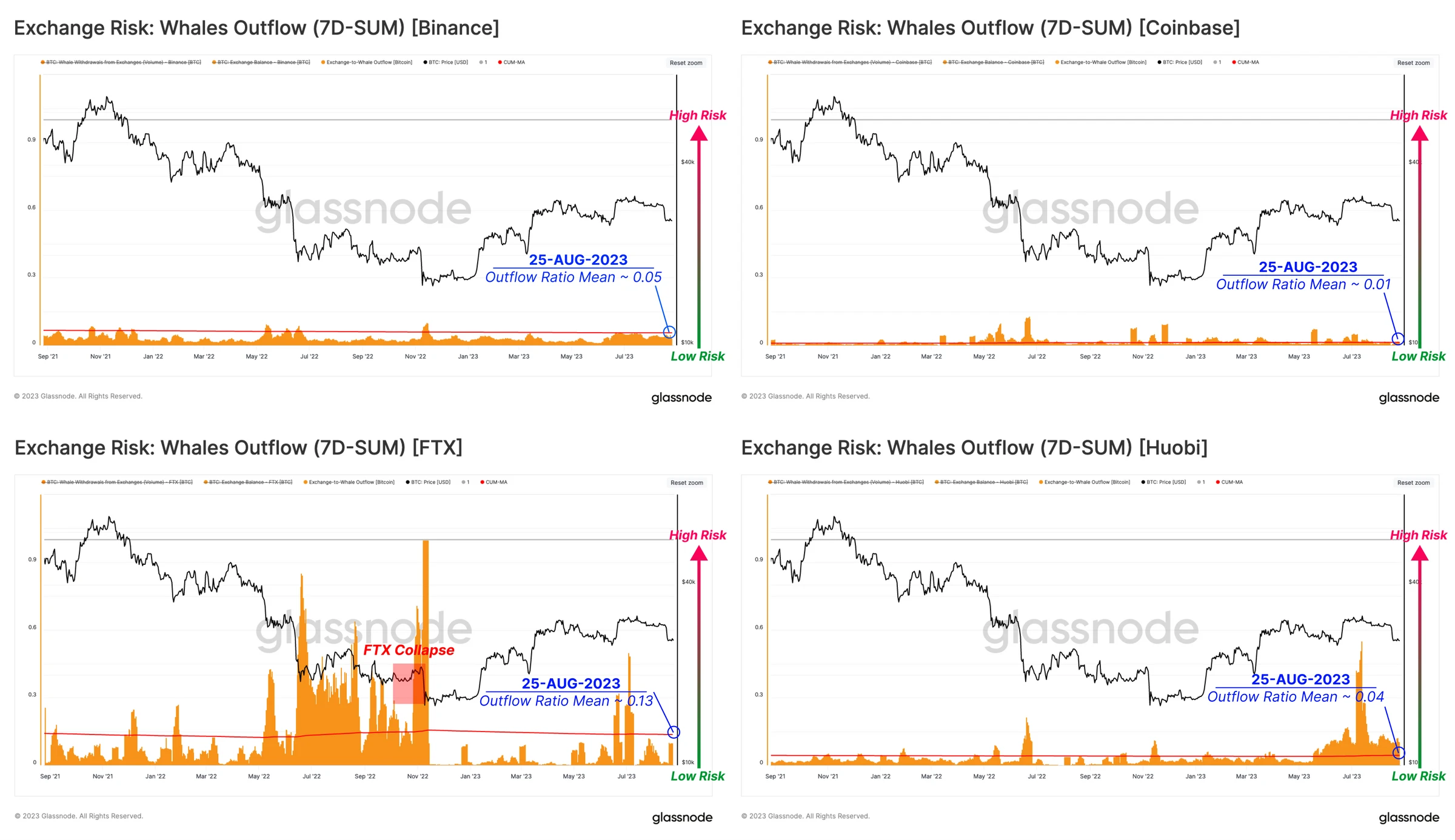
Conclusion
The failure of FTX serves as a reminder to the digital asset industry that counterparty risk still exists within CEXs and custodians. Guided by hindsight, we propose three indicators that leverage our on-chain data and labeled clusters to provide a straightforward view of some potential risks within exchanges.
We find that through the internal transfer rate, exchange dependency rate, and whale withdrawal rate, the on-chain data for Coinbase and Binance is similar and safe. Unfortunately, FTX serves as a notable case of risk indicators, and for Huobi, the continuous decline in the balances of the four major assets (BTC, ETH, USDT, and USDC) will worsen these indicators, suggesting a need for a certain degree of caution.













